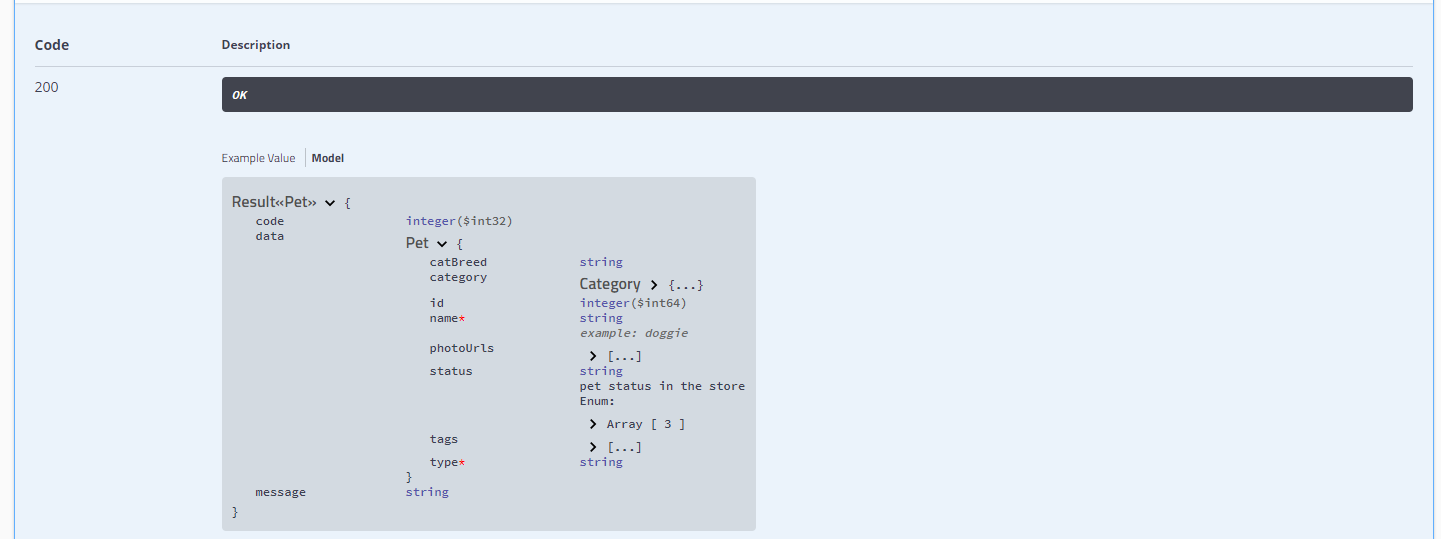Swagger文档API学习--ApiModel注解
Swagger文档API学习–ApiModel注解
@ApiModel这个注解是比较重要的一个注解。因为在实际的开发过程中,我们知道了请求的地址后,我们更加重要的是关心这个接口的请求入参和返回值。而对于@ApiModel这个注解,可以良好的展示出请求参数的含义和返回参数的含义。
源码展示
import java.lang.annotation.ElementType;
import java.lang.annotation.Inherited;
import java.lang.annotation.Retention;
import java.lang.annotation.RetentionPolicy;
import java.lang.annotation.Target;
/**
* Provides additional information about Swagger models.
* <p>
* Classes will be introspected automatically as they are used as types in operations,
* but you may want to manipulate the structure of the models.
*/
@Target({ElementType.TYPE})
@Retention(RetentionPolicy.RUNTIME)
@Inherited
public @interface ApiModel {
/**
* Provide an alternative name for the model.
* <p>
* By default, the class name is used.
*/
String value() default "";
/**
* Provide a longer description of the class.
*/
String description() default "";
/**
* Provide a superclass for the model to allow describing inheritance.
*/
Class<?> parent() default Void.class;
/**
* Supports model inheritance and polymorphism.
* <p>
* This is the name of the field used as a discriminator. Based on this field,
* it would be possible to assert which sub type needs to be used.
*/
String discriminator() default "";
/**
* An array of the sub types inheriting from this model.
*/
Class<?>[] subTypes() default {};
/**
* Specifies a reference to the corresponding type definition, overrides any other metadata specified
*/
String reference() default "";
}@ApiModel这个注解
这个注解的是作用在类上面的,是用来描述类的一些基本信息的。下面,我们会逐个的进行讲解。
value属性
这个属性,提供的是类的一个备用名。如果我们不设置的的话,那么默认情况下,将使用的是class类的名字。
description属性
对于类,提供一个详细的描述信息
parent属性
这个属性,描述的是类的一些父类的信息。
discriminator属性
这个属性解释起来有些麻烦,因为这个类主要是体现出了断言当中。
subTypes属性
举个实例,如果我们此时有一个父类Animal。同时,对于这个父类,我们的系统中有这个类的子类Cat、Dog、Pig等。如果我们在我们的父类上,通过这个属性,指定了我们想要使用的子类的话,那么在生成Swagger的文档的话,会自动的展示的是Animal这个属性,但是在属性的字段中,会显示出子类的一些独有的属性,其实在这里,是不推荐使用的。因为这样会让别人认为,这些子类独有的属性,也是父类才有的。
假如我们有如下的几个类:
Pet类
@ApiModel(value = "Pet", subTypes = {Cat.class},discriminator = "type")
public class Pet {
private long id;
private Category category;
private String name;
private List<String> photoUrls = new ArrayList<String>();
private List<Tag> tags = new ArrayList<Tag>();
@ApiModelProperty(value = "pet status in the store", allowableValues = "available,pending,sold")
private String status;
public long getId() {
return id;
}
public void setId(long id) {
this.id = id;
}
public Category getCategory() {
return category;
}
public void setCategory(Category category) {
this.category = category;
}
@ApiModelProperty(example = "doggie", required = true)
public String getName() {
return name;
}
public void setName(String name) {
this.name = name;
}
public List<String> getPhotoUrls() {
return photoUrls;
}
public void setPhotoUrls(List<String> photoUrls) {
this.photoUrls = photoUrls;
}
public List<Tag> getTags() {
return tags;
}
public void setTags(List<Tag> tags) {
this.tags = tags;
}
public String getStatus() {
return status;
}
public void setStatus(String status) {
this.status = status;
}
private String type;
@ApiModelProperty(required = true)
public String getType() {
return type;
}
public void setType(String type) {
this.type = type;
}
}Cat类
import javax.xml.bind.annotation.XmlRootElement;
public class Cat extends Pet {
String catBreed;
public String getCatBreed() {
return catBreed;
}
public void setCatBreed(String catBreed) {
this.catBreed = catBreed;
}
}接口类
public interface OrderWebApi {
@RequestMapping(value = "/shen/testOne",method = RequestMethod.GET)
Result<Cat> getOrderDetail(@RequestParam("order_id") Integer orderId);
}真正的Controller类
@RestController
public class OrderWebController implements OrderWebApi {
@Override
public Result<Cat> getOrderDetail(Integer orderId) {
System.out.println(orderId);
OrderWebResVo orderWebResVo = new OrderWebResVo();
orderWebResVo.setAb(SexEnum.MAN);
orderWebResVo.setAge(20);
orderWebResVo.setMoney(4000L);
orderWebResVo.setMoneyOne(3000.0F);
orderWebResVo.setName("shen");
orderWebResVo.setSex(new Byte("1"));
Result<Cat> result = new Result<>();
result.setCode(20080);
result.setMessage("SUCCESS");
result.setData(new Cat());
return result;
}
}
但是真正的Swagger文档为

reference属性
指定对相应类型定义的引用,覆盖指定的任何其他元数据。
总结
这个注解主要讲解的是model的信息信息,但是对于POJO中的内在属性需要参考下一篇文章讲解的@ApiModelProperty属性。
转载请注明来源,欢迎指出任何有错误或不够清晰的表达。可以邮件至 gouqiangshen@126.com
文章标题:Swagger文档API学习--ApiModel注解
文章字数:1.1k
本文作者:BiggerShen
发布时间:2019-11-01, 15:25:31
最后更新:2024-01-16, 03:51:15
原始链接:https://shengouqiang.cn/Swagger/SwaggerDocumentLearnDay04/版权声明: 转载请保留原文链接及作者。

